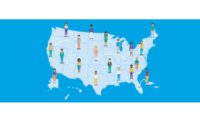Survey: Number of U.S. Architects on the Rise

The number of architects licensed in the United States rose to 113,554, according to the 2017 Survey of Architectural Registration Boards. This represents a 3 percent increase from 2016 and a 10 percent increase from the number of U.S. architects reported a decade ago.
Conducted annually by the National Council of Architectural Registration Boards (NCARB), the survey provides exclusive insight into data from the architectural licensing boards of the 50 U.S. states, the District of Columbia, Guam, Puerto Rico, and the U.S. Virgin Islands.
The health of the architecture profession is even more apparent when compared to the U.S. population: the number of architects licensed in the United States has risen over 10 percent since 2008, while the total U.S. population has risen 8 percent, according to data from the U.S. Census Bureau.
“With approximately one architect for every 2,900 people in the United States, each architect has the daily opportunity to significantly impact the built environment—and those who live, work, and play in it,” said NCARB President Gregory L. Erny, FAIA, NCARB, Hon. FCARM.
The survey also revealed that there are still more reciprocal (out-of-state) licenses than resident licenses issued across the U.S. Although the number of reciprocal licenses reported in 2017 fell to 125,348 (a 1 percent decrease), this number is the second highest on record—indicating that architects continue to have the mobility they need to seek work across state borders.
In 2017, over 5,200 candidates completed the core education, experience, and examination requirements for licensure—a record high. This has contributed to the increase in the number of licensed architects, and suggests that the profession should benefit from a healthy pipeline in the coming years.
“This year’s data not only shows that licensure remains valued within the architecture field,” said NCARB CEO Michael J. Armstrong. “It also demonstrates that NCARB’s efforts to streamline the path to licensure and remove unnecessary barriers have been effective. We’ve achieved this while maintaining rigor and ensuring each board’s ability to protect the public.”
The survey reflects registration data from January to December 2017. Additional data on the path to licensure will be available in July’s 2018 edition of NCARB by the Numbers.
To learn more about NCARB’s data and the Survey of Architectural Registration Boards, visit www.ncarb.org.
Looking for a reprint of this article?
From high-res PDFs to custom plaques, order your copy today!






